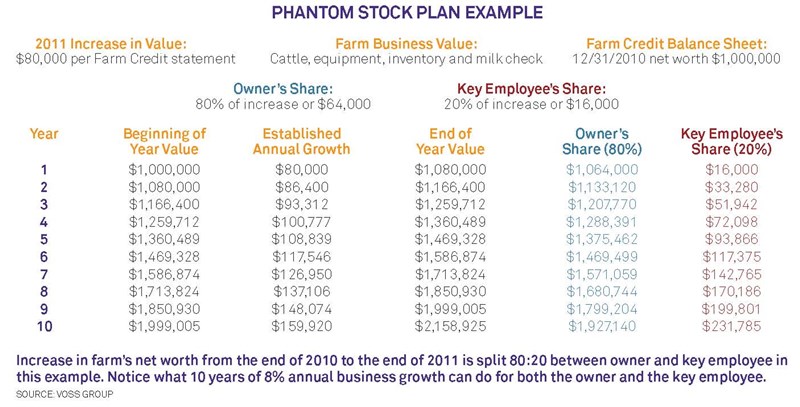Deferred Gratification

Phantom stock rewards, helps retain select employees
The promise of partial ownership isn’t the only way to snag and retain exceptional employees. Issuing units of "phantom stock" is a new twist on an old strategy of deferring compensation that commonly stood on four hooves.
"When you want to encourage an employee to be concerned about the growth and success of the entire business, phantom stock is useful," explains Elwyn Voss of the Voss Group, Norwich, N.Y. "It’s an accounting mechanism measured in units that allows you to systematically share the growth in equity value year after year, but without ownership."
Bonus Content: More on Phantom Stock Plans
Voss and his associates have provided farms and families in the Northeast with business organization, retirement and succession planning for 35 years.
"The beauty of this is you don’t have to be an owner to have a say in the business," Voss says. "You can get a lot of control by doing your management responsibility and doing it well, earning rights and respect along the way."
Here’s how it works. Phantom stock is identical to a share of business stock in terms of equity value, but is "phantom" because it doesn’t have any physical form. In simple terms, it represents a contractual arrangement between an owner and a key employee that says at some time in the future the employee is entitled to receive the value of each unit.
As the farm business value rises and falls, so does the phantom stock unit, fostering a "we pull together" culture.
Originated in the corporate world decades ago, Voss says, phantom stock is more and more common in ag businesses, where benefit caps and limits abound.
What we’re all more familiar with is the promise of cattle or real estate after investing an arbitrary number of years of "sweat equity." This has been the norm in agriculture’s cash-restrained economy.

Flexible and unique, phantom stock can be set up however the employer wishes, similar to the way buy-sell agreements are crafted. For example, you may define a vesting schedule that encourages at least five or more years’ service before any units are granted.
You may determine that if an employee quits early, there will be no payout until an agreed-upon retirement age. It may suit you to offer a combination of phantom stock and cash bonuses.
Further, if you’ve lured an employee away from another career with a higher cash salary than you can afford, you can make up the difference in phantom stock units in order to be competitive. Regardless, it’s a written document that specifies details.
In this age of lenders insisting that every owner of "real" stock—even minority owners—sign personal guarantees on farm loan applications, a phantom stock plan eliminates the hassle. "It’s just cleaner, simpler to deal with units," Voss says.
Tax benefits apply in most cases to both the employee and the employer, he adds. The value of the units isn’t taxed to the worker until paid out, and stock awards are generally tax-deductible to the company. Of course, you will need to consult your own professional advisers for
legal and tax implications.
Companies commonly invest money along the way to fund the payout, sometimes using a life insurance policy that also provides an accumulation of some cash.
"This is definitely not for the rank-and-file employee," Voss says. "You’ll consider this for perhaps the top 10% of employees—those who are really excited about growth and longevity."
Ownership isn’t necessarily off the table in this stock plan. A choice worker may opt to use the value of his accumulated units to buy into the business at some point down the road. For example, $100,000 worth of units earned will have drawn a $1 million business down to $900,000—making "a piece of the action" that much more attainable.
Phantom stock is useful when plotting strategy for farm transfers within a family, too, or when you need to bridge a gap while waiting for additional family members to come into the business. Sometimes it’s a vehicle for compensating family members outside of the family business. Voss has even designed plans where units go to youngsters earning their way into management, as well as to parents with an eye to retirement.







